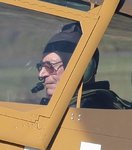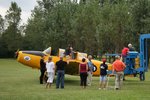RAF veteran who flew secret mission told it's too dangerous to sit in Spitfire - Telegraph
08 Jan 2012
Eric Carter is the last surviving member of Force Benedict, a secret mission to protect Murmansk, the port in northern Russia that was a crucial lifeline to the Soviets, but he was shot down at the Potteries Museum and Art Gallery near Stoke-on-Trent.
He was delighted to get the chance to inspect a Spitfire and then amused that he could not get in it. "I had to laugh to think that I couldn't sit in a stationary Spitfire in case I got hurt," said Mr Carter, from Worcestershire. "I used to fly those things every day fighting the Germans. Now that really was a health and safety concern!
"But you have to chuckle. I don't think they meant any harm, and they gave me a lovely day out at their museum."
Mr Carter trained as a pilot in Stoke before taking part in Force Benedict. The clandestine operation remained largely unknown for decades because Stalin did not want to admit that he had asked for help from Britain, but Mr Carter is feted in Russia now and was even a guest of honour when the Queen made her first State visit to the country in 1994.
"Force Benedict was a very well-kept secret," he said. "We were threatened with a court martial if we said anything.
09 Jan 2012
"Murmansk was all rubble and the Russian soldiers didn't bother to ask who you were — they killed you on sight if they didn't like the look of you. We were issued with special passes and had to hold them in front of us as we walked anywhere or we would have been shot.
"It was freezing. Our aircraft and vehicles had to be started up every 20 minutes to prevent them freezing for good."
The RAF pilots carried out 365 sorties during a four-month stay in Murmansk and in October 1941 they handed over defence of the port to the Russians. By then the weather was worsening and the German invasion began to stall.
Mr Carter married Phyllis, a "wonderful wife and mother", while on leave in 1943, and saw out the war in Burma. Mrs Carter died in 2005.
A spokesman for Stoke-on-Trent city council, which represents the Potteries Museum, said officials had little choice but keep Mr Carter out of the plane. "The cockpit had recently been painted with paint containing radium, which is radioactive, and there is no proper seat in the Spitfire at the moment so I am told the people on the day thought it best he did not sit in the plane for those reasons because of his age," he said.
Mr Carter laughed off the episode. "They were probably just trying to be extra careful, which was very nice," he said. "I just wish the Luftwaffe had been so caring."
What a contrast with Bud Anderson flying his Mustang, isn't? At least the museum could have told him to make medical exams to sit in the plane. My grandfather died at 91, and I used to hate people treating him like this. One day he was drinking with me, and a person came and ask: "hey sir, and your blood pressure?" His pressure was actually lower than mine, who was a teenager at the time. Absurd.
08 Jan 2012
Eric Carter is the last surviving member of Force Benedict, a secret mission to protect Murmansk, the port in northern Russia that was a crucial lifeline to the Soviets, but he was shot down at the Potteries Museum and Art Gallery near Stoke-on-Trent.
He was delighted to get the chance to inspect a Spitfire and then amused that he could not get in it. "I had to laugh to think that I couldn't sit in a stationary Spitfire in case I got hurt," said Mr Carter, from Worcestershire. "I used to fly those things every day fighting the Germans. Now that really was a health and safety concern!
"But you have to chuckle. I don't think they meant any harm, and they gave me a lovely day out at their museum."
Mr Carter trained as a pilot in Stoke before taking part in Force Benedict. The clandestine operation remained largely unknown for decades because Stalin did not want to admit that he had asked for help from Britain, but Mr Carter is feted in Russia now and was even a guest of honour when the Queen made her first State visit to the country in 1994.
"Force Benedict was a very well-kept secret," he said. "We were threatened with a court martial if we said anything.
09 Jan 2012
"Murmansk was all rubble and the Russian soldiers didn't bother to ask who you were — they killed you on sight if they didn't like the look of you. We were issued with special passes and had to hold them in front of us as we walked anywhere or we would have been shot.
"It was freezing. Our aircraft and vehicles had to be started up every 20 minutes to prevent them freezing for good."
The RAF pilots carried out 365 sorties during a four-month stay in Murmansk and in October 1941 they handed over defence of the port to the Russians. By then the weather was worsening and the German invasion began to stall.
Mr Carter married Phyllis, a "wonderful wife and mother", while on leave in 1943, and saw out the war in Burma. Mrs Carter died in 2005.
A spokesman for Stoke-on-Trent city council, which represents the Potteries Museum, said officials had little choice but keep Mr Carter out of the plane. "The cockpit had recently been painted with paint containing radium, which is radioactive, and there is no proper seat in the Spitfire at the moment so I am told the people on the day thought it best he did not sit in the plane for those reasons because of his age," he said.
Mr Carter laughed off the episode. "They were probably just trying to be extra careful, which was very nice," he said. "I just wish the Luftwaffe had been so caring."
What a contrast with Bud Anderson flying his Mustang, isn't? At least the museum could have told him to make medical exams to sit in the plane. My grandfather died at 91, and I used to hate people treating him like this. One day he was drinking with me, and a person came and ask: "hey sir, and your blood pressure?" His pressure was actually lower than mine, who was a teenager at the time. Absurd.
Last edited:


